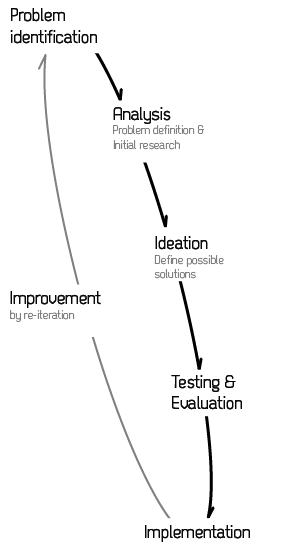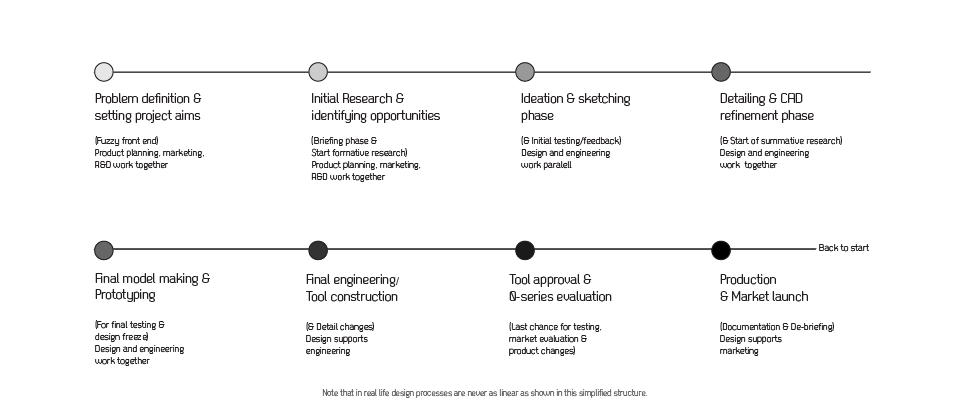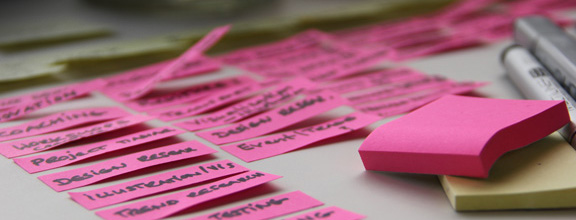Designing is a creative problem solving process and follows a cycle of investigation and understanding, re-phrasing and ideation, evaluation and refinement. While everyone applies such cycles in daily life, in professional design projects it is consciously orchestrated and pursued with a specific set of tools.
We have an array of tools to deeply understand, creatively respond, visualize and test ideas. This guarantees a structured and more efficient solution finding process. Creative techniques within, make sure to switch perspectives and explore a range of ideas, rather than settling for the most obvious first best option. With every insight, idea development and testing cycle knowledge becomes more dense and accurate. After several iterative cycles, which go deeper and deeper into the problem and solution approach a more successful solution can be implemented.
This iterative cycle is the blueprint for the entire design process, but happens also in each detail development step. The more complex a task or problem is, the more cycles we are likely to run through to reach a successful solution.
The first draft is never the final outcome, but a simplified concept or an expressed ideal (compromise-free) solution. In the refinement phase this ideal is converted into a feasible product, sometimes with a very different structure and form than initially anticipated, but carrying the core values and ideas to the market.
In order to analyse a design problem or to evaluate an idea or possible solution OND follows the design research rule of: Don't assume. Ask, Observe, Perform!
We know that it is very tempting to stay at ones desk in order to work on a product development or design task. Time seems too precious to leave in order to talk to users, investigate their environment and the market first hand. Bench mark competitor products, trying them out or building a range of models to test in real life is hard work.
However what seemed a good idea on paper (or screen) is not always working in real life. Finding out that users do not understanding the concept in the first place or having very different priorities or usage patterns is invaluable. It can safe hours and hours of costly development time. Therefore it pays off in the long run to find this out as soon as possible..
The mantra a successful design and innovation processes is "fail early and fail often". It is clearly cheaper to change the product specification list, a card board model than a steel injection moulding tool or pushing medioucre products with expensive PR campaigns.
OND therefore applies Design Thinking and Agile Development Tools to get it right early. Some extra hours on initial research and testing even though the task and problems seem obvious or a certain solutions seems already like the winner in theory pay off.
It is amazing what a little extra time spend on observing a product in its environment, testing a paper mock-up or asking users about a their impression on photo realistic renderings of an concept can reveal. Even better, involving your customers or users in a Co-Creation process. Who else than the user knows what works best for them, while you know how to make it happen.


How to get started

Note down some keywords around your project.
Use Mind map template to get started (download here). Additionally compile some visual material explaining
your project or inspirations.
Summarize essential information about the project you envision. This can be simply re-styling a product or technical concept, idea visualization, new product development, identify opportunities through market and trend reviews or new technology or material use. See project brief as a guide.
Get in contact with us to arrange an initial free consultation and quote. Feel free to propose what the work would be worth to you - we will look into reasonable proposals if the challenge is interesting to us.
Arrange a kick-off workshop with all parties/people involved in the project to collect all existing information, ideas, want and needs. Invite at least a representative of decision makers and strategic leaders, marketing, product planning, engineering (R&D), production/manufacturing and design team.
This will enable a flying start with clear communication and already a pile of feasible ideas to work on and test. We are trained moderators and enable a efficient and result-driven use of the groups time together.
Mindmap Project Brief K-WorkshoP